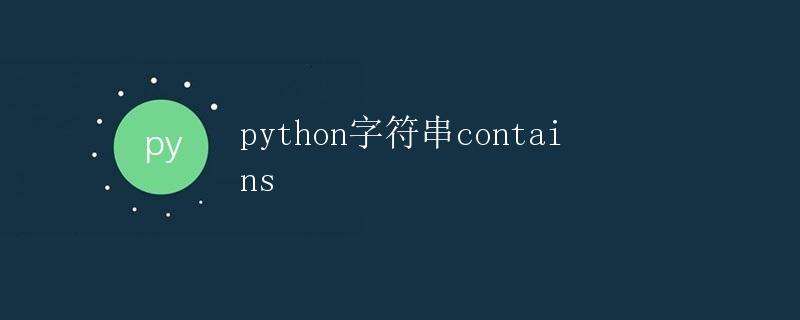Python字符串contains

在Python中,我们经常需要判断一个字符串中是否包含另一个字符串。这个过程通常被称为“contains”,即包含的意思。本文将详细讨论如何使用Python来判断一个字符串是否包含另一个字符串,并给出一些示例代码。
1. 使用”in”关键字判断字符串包含关系
在Python中,我们可以使用in关键字来判断一个字符串是否包含另一个字符串。具体用法如下:
string1 = "Hello, World!"
string2 = "Hello"
if string2 in string1:
print("string1 contains string2")
else:
print("string1 does not contain string2")
上面的代码简单地判断了string1中是否包含string2,如果包含则输出”string1 contains string2″,否则输出”string1 does not contain string2″。
2. 使用find()方法查找子字符串
除了使用in关键字外,我们还可以使用字符串的find()方法来查找子字符串在父字符串中的位置。如果找到了子字符串,则返回子字符串在父字符串中的起始位置,如果找不到则返回-1。
示例代码如下:
string1 = "Hello, World!"
string2 = "Hello"
index = string1.find(string2)
if index != -1:
print(f"string1 contains string2 at index {index}")
else:
print("string1 does not contain string2")
上面的代码通过find()方法找到了string2在string1中的起始位置,并输出了该位置。如果找不到string2,则输出”string1 does not contain string2″。
3. 使用count()方法计算子字符串出现次数
有时候我们并不仅仅想知道一个字符串是否包含另一个字符串,而是想知道一个字符串中另一个字符串出现的次数。这时可以使用count()方法来计算子字符串在父字符串中出现的次数。
示例代码如下:
string1 = "Hello, hello, hello, World!"
string2 = "hello"
count = string1.count(string2)
if count > 0:
print(f"string1 contains {string2} {count} times")
else:
print("string1 does not contain string2")
上面的代码通过count()方法计算了string2在string1中出现的次数,并输出了该次数。
4. 使用正则表达式判断字符串包含关系
除了前面介绍的方法外,我们还可以使用正则表达式来判断一个字符串是否包含另一个字符串。这种方法更加灵活,可以实现更复杂的匹配规则。
示例代码如下:
import re
string1 = "Hello, World!"
string2 = "hello"
pattern = re.compile(string2, re.IGNORECASE)
if re.search(pattern, string1):
print("string1 contains string2")
else:
print("string1 does not contain string2")
上面的代码通过正则表达式来忽略大小写地判断string1中是否包含string2。
结语
本文介绍了在Python中判断一个字符串是否包含另一个字符串的几种方法,包括使用in关键字、find()方法、count()方法和正则表达式。读者可以根据具体情况选择合适的方法来处理字符串包含关系。
 极客教程
极客教程